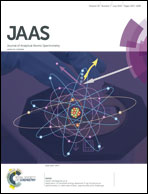Direct mercury analysis in environmental solids by ICP-MS with on-line sample ashing and mercury pre-concentration using a direct mercury analyzer
Abstract
A commercially available direct mercury analyzer (DMA) based on sample combustion, pre-concentration by amalgamation with gold, and atomic absorption spectrophotometry (AAS) was coupled to a sector field inductively coupled plasma mass spectrometer (ICP-MS). The combined system (DMA-ICP-MS) was optimized and evaluated for the determination of mercury in environmental samples using both external calibration and isotope dilution for quantitation. The method was validated using certified reference materials, including sediment, leaves, and fish-muscle tissue. The limit of detection was ∼0.37 pg, about two orders of magnitude lower than the DMA system alone. Precision was generally <7% relative standard deviation, and total analysis time per sample was <8 min. The DMA-ICP-MS system has several advantages over both the DMA alone and conventional cold-vapor AAS for the determination of mercury, including increased sensitivity, lower detection limits, decreased potential for sample contamination, and applicability to Hg stable isotope tracer studies.


 Please wait while we load your content...
Please wait while we load your content...